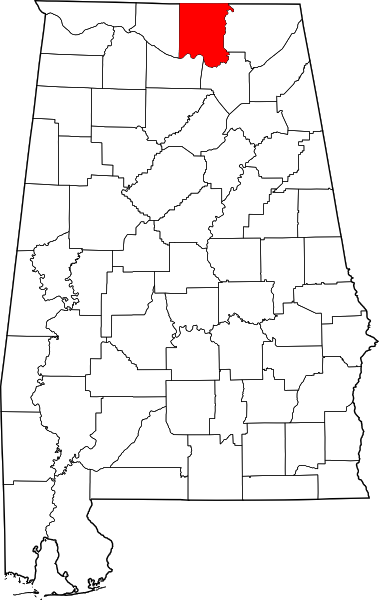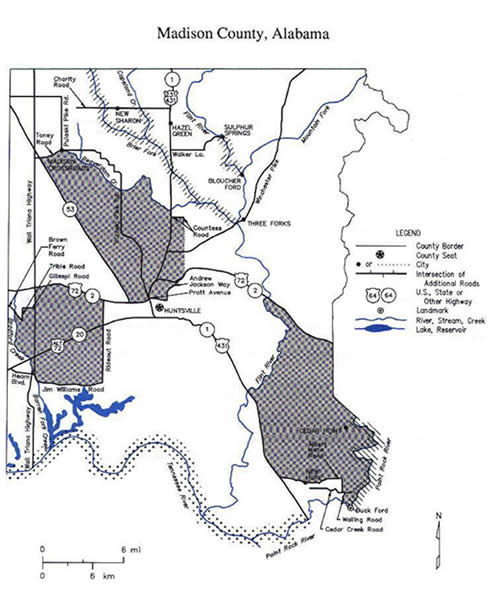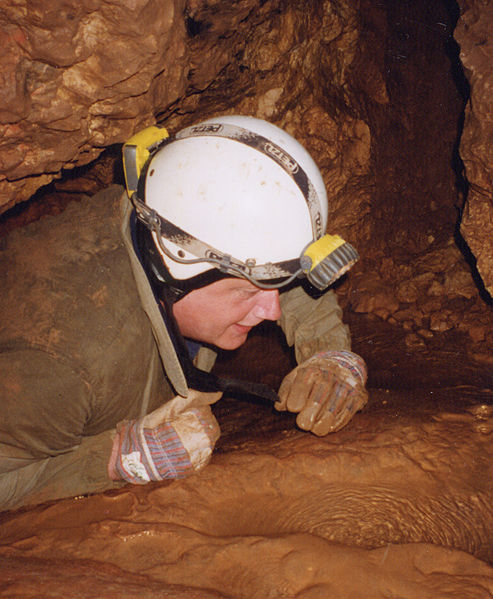Alabama Cave Shrimp - BIO203
Home is Where the Heart Is:
 The Alabama Cave
Shrimp have been found in five different caves in Alabama, which are
located in Madison County, highlighted in red on the map (McGregor et al. 2005; Bibb
et al. 2006).
These caves include Shelta Cave, Bobcat Cave, and a cave complex made up
of Hering Cave, Glover Cave, and Brazelton Cave (Bibb et al. 2006,
Jacobson and Hartfield 1997). However, no Alabama Cave Shrimp have been
observed in Shelta Cave since 1973 (McGregor et al. 2005). The
dark gray shaded areas on the map below show the areas in Madison
County, Alabama where Alabama Cave Shrimp have been found. For more information on
Madison County and the map below please click
here.
The Alabama Cave
Shrimp have been found in five different caves in Alabama, which are
located in Madison County, highlighted in red on the map (McGregor et al. 2005; Bibb
et al. 2006).
These caves include Shelta Cave, Bobcat Cave, and a cave complex made up
of Hering Cave, Glover Cave, and Brazelton Cave (Bibb et al. 2006,
Jacobson and Hartfield 1997). However, no Alabama Cave Shrimp have been
observed in Shelta Cave since 1973 (McGregor et al. 2005). The
dark gray shaded areas on the map below show the areas in Madison
County, Alabama where Alabama Cave Shrimp have been found. For more information on
Madison County and the map below please click
here.

Bobcat Cave is located
within the Redstone Arsenal, a United States Army Facility in Madison
County, Alabama, so it is subject to government laws and regulations,
including the Endangered Species Act (ESA) (McGregor et al. 2005; Bibb
et al. 2006). Under the ESA, the Alabama Cave Shrimp are provided
protection from cavers and collectors, but can still be studied by
researchers. The cave complex (Hering, Glover, and Brazelton Caves) is
on private land and does not have these restrictions, making it more
difficult to maintain the population there because it is easily
accessible to collectors who may remove the shrimp or cavers who may
accidentally kill them (Bibb et al. 2006).
Cavers are not expecting to find these organisms, and are more prepared
to find bats, like the
Antrozous pallidus, so their surprise may lead to more
damage for the Alabama Cave Shrimp.
 Bobcat Cave is located on a
limestone plain near the Tennessee River, which is the body of water
that causes the ground-water movement through and around Bobcat Cave
(McGregor et al. 2005). There are also many large carbonate rocks under
this plain that could be contributing to the unexpected ion
concentrations in the water tested within the cave (McGregor et al.
2005). A study was done observing the Alabama Cave Shrimp in Bobcat
Cave over several years, and water samples were taken each time and
tested for various chemicals and substances (McGregor et al.
2005). This study took place from November 1990 to September 2005. Each
time the number of Alabama Cave Shrimp were observed and recorded
(McGregor et al. 2005). Generally, more shrimp were present when water
elevations were lower, with the most being seen in August. However, none
have ever been observed in February, March, or April because the high
water levels blocked the cave entrances and researchers could not access
the cave (McGregor et al. 2005). The water that the Alabama Cave Shrimp
live in has a median pH of 6.0-7.5, but is usually slightly acidic
because the chloride ion concentration in the area is fairly high,
considering there are not usually any chloride ions present in fresh
water (McGregor et al. 2005). The average water temperature is 14.3ºC,
but it ranges anywhere from 13ºC to 15ºC (McGregor et al. 2005).
Bobcat Cave is located on a
limestone plain near the Tennessee River, which is the body of water
that causes the ground-water movement through and around Bobcat Cave
(McGregor et al. 2005). There are also many large carbonate rocks under
this plain that could be contributing to the unexpected ion
concentrations in the water tested within the cave (McGregor et al.
2005). A study was done observing the Alabama Cave Shrimp in Bobcat
Cave over several years, and water samples were taken each time and
tested for various chemicals and substances (McGregor et al.
2005). This study took place from November 1990 to September 2005. Each
time the number of Alabama Cave Shrimp were observed and recorded
(McGregor et al. 2005). Generally, more shrimp were present when water
elevations were lower, with the most being seen in August. However, none
have ever been observed in February, March, or April because the high
water levels blocked the cave entrances and researchers could not access
the cave (McGregor et al. 2005). The water that the Alabama Cave Shrimp
live in has a median pH of 6.0-7.5, but is usually slightly acidic
because the chloride ion concentration in the area is fairly high,
considering there are not usually any chloride ions present in fresh
water (McGregor et al. 2005). The average water temperature is 14.3ºC,
but it ranges anywhere from 13ºC to 15ºC (McGregor et al. 2005).
Increased
urbanization is hypothesized endanger
the Alabama Cave Shrimp (McGregor et al. 2005; Bibb et al.
2006).
 The
land around the Redstone Arsenal is becoming more developed, mostly for
suburban neighborhoods, which will likely contribute to ground water
pollution (McGregor et al. 2005; Jacobson and Hartfield 1997).
Researchers believe that ground water contamination poses the
greatest threat to the Alabama Cave Shrimp right now, especially lead
(Bibb et al. 2006). The Redstone Arsenal is surrounded by land that was
used as grazing pastures for cattle. This depleted nutrients usually
present in water and instead added more nitrogen and other products
found in waste (Bibb et al. 2006). The use of the land for agricultural
purposes is now banned, improving the water quality in Bobcat Cave and
may soon show an improvement in numbers of Alabama Cave Shrimp (Bibb et
al. 2006).
The
land around the Redstone Arsenal is becoming more developed, mostly for
suburban neighborhoods, which will likely contribute to ground water
pollution (McGregor et al. 2005; Jacobson and Hartfield 1997).
Researchers believe that ground water contamination poses the
greatest threat to the Alabama Cave Shrimp right now, especially lead
(Bibb et al. 2006). The Redstone Arsenal is surrounded by land that was
used as grazing pastures for cattle. This depleted nutrients usually
present in water and instead added more nitrogen and other products
found in waste (Bibb et al. 2006). The use of the land for agricultural
purposes is now banned, improving the water quality in Bobcat Cave and
may soon show an improvement in numbers of Alabama Cave Shrimp (Bibb et
al. 2006).
Now that you know where these organisms can be found, go to the next page, Form and Function, to see what they do.